VAUXHALL ASTRA J 2016.5 Repair Manual
Manufacturer: VAUXHALL, Model Year: 2016.5, Model line: ASTRA J, Model: VAUXHALL ASTRA J 2016.5Pages: 343, PDF Size: 10.44 MB
Page 61 of 343

Seats, restraints59IL:suitable for particular ISOFIX restraint systems of the 'specific-vehicle', 'restricted' or 'semi-universal' categories.The ISOFIX restraint system must be approved for the specific vehicle type.IUF:suitable for ISOFIX forward-facing child restraint systems of universal category approved for use in this weight class.X:no ISOFIX child restraint system approved in this weight class.
ISOFIX size class and seat device
A – ISO/F3:forward-facing child restraint system for children of maximum size in the weight class 9 to 18 kgB – ISO/F2:forward-facing child restraint system for smaller children in the weight class 9 to 18 kgB1 – ISO/F2X:forward-facing child restraint system for smaller children in the weight class 9 to 18 kgC – ISO/R3:rear-facing child restraint system for children of maximum size in the weight class up to 18 kgD – ISO/R2:rear-facing child restraint system for smaller children in the weight class up to 18 kgE – ISO/R1:rear-facing child restraint system for young children in the weight class up to 13 kg
Page 62 of 343
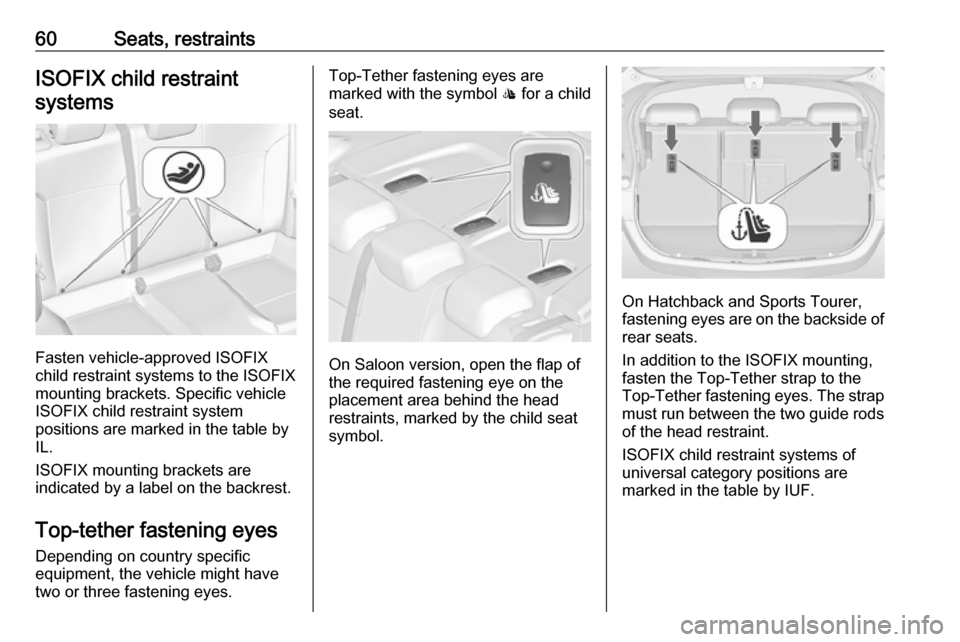
60Seats, restraintsISOFIX child restraintsystems
Fasten vehicle-approved ISOFIX
child restraint systems to the ISOFIX
mounting brackets. Specific vehicle
ISOFIX child restraint system
positions are marked in the table by
IL.
ISOFIX mounting brackets are
indicated by a label on the backrest.
Top-tether fastening eyes Depending on country specific
equipment, the vehicle might have
two or three fastening eyes.
Top-Tether fastening eyes are
marked with the symbol : for a child
seat.
On Saloon version, open the flap of
the required fastening eye on the
placement area behind the head restraints, marked by the child seat
symbol.
On Hatchback and Sports Tourer,
fastening eyes are on the backside of
rear seats.
In addition to the ISOFIX mounting,
fasten the Top-Tether strap to the
Top-Tether fastening eyes. The strap
must run between the two guide rods of the head restraint.
ISOFIX child restraint systems of
universal category positions are
marked in the table by IUF.
Page 63 of 343
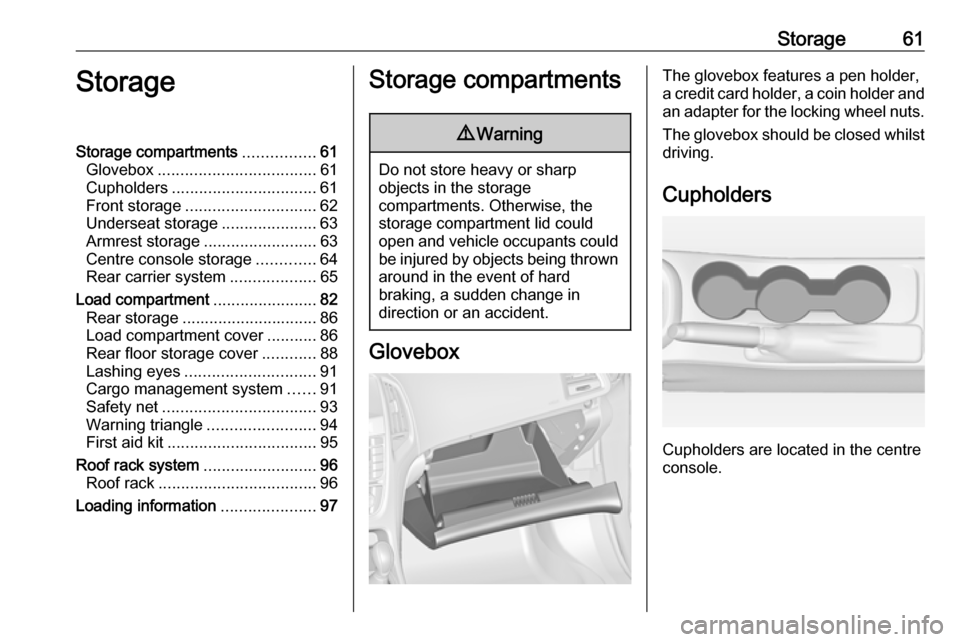
Storage61StorageStorage compartments................61
Glovebox ................................... 61
Cupholders ................................ 61
Front storage ............................. 62
Underseat storage .....................63
Armrest storage .........................63
Centre console storage .............64
Rear carrier system ...................65
Load compartment .......................82
Rear storage .............................. 86
Load compartment cover ...........86
Rear floor storage cover ............88
Lashing eyes ............................. 91
Cargo management system ......91
Safety net .................................. 93
Warning triangle ........................94
First aid kit ................................. 95
Roof rack system .........................96
Roof rack ................................... 96
Loading information .....................97Storage compartments9Warning
Do not store heavy or sharp
objects in the storage
compartments. Otherwise, the
storage compartment lid could
open and vehicle occupants could be injured by objects being thrown
around in the event of hard
braking, a sudden change in
direction or an accident.
Glovebox
The glovebox features a pen holder,
a credit card holder, a coin holder and
an adapter for the locking wheel nuts.
The glovebox should be closed whilst
driving.
Cupholders
Cupholders are located in the centre
console.
Page 64 of 343
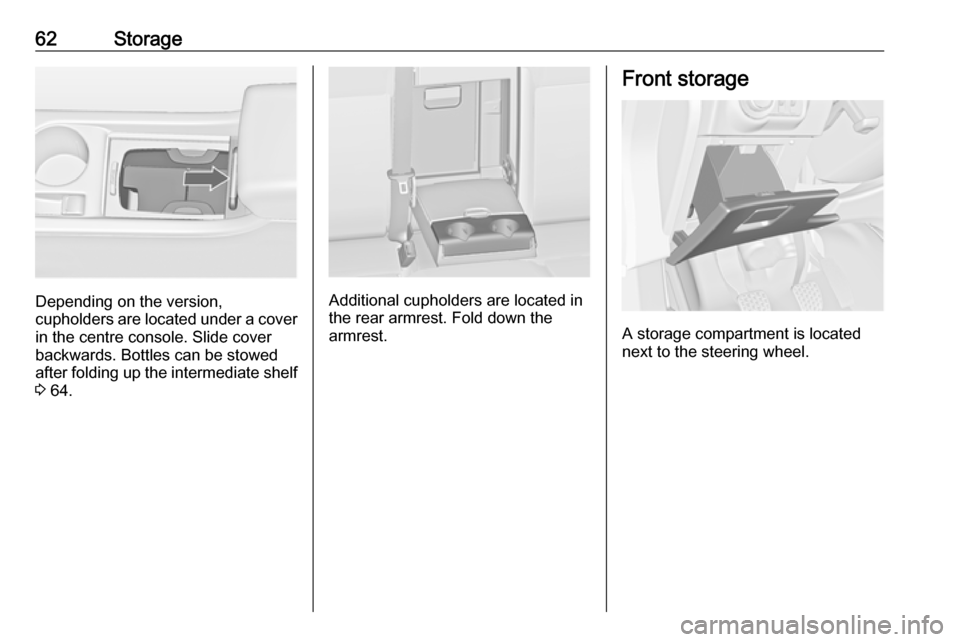
62Storage
Depending on the version,
cupholders are located under a cover
in the centre console. Slide cover
backwards. Bottles can be stowed
after folding up the intermediate shelf 3 64.Additional cupholders are located in
the rear armrest. Fold down the
armrest.
Front storage
A storage compartment is located
next to the steering wheel.
Page 65 of 343
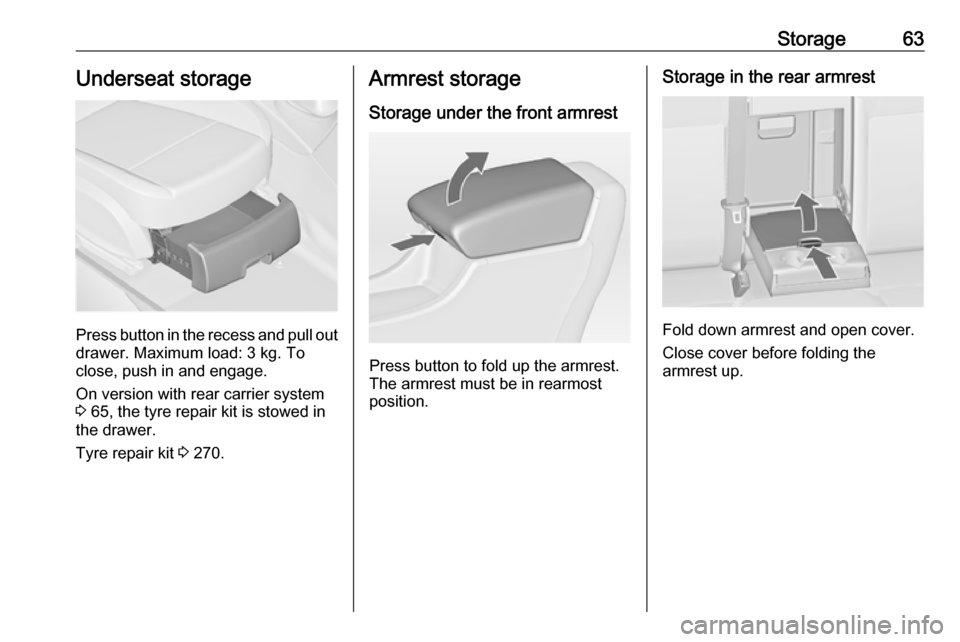
Storage63Underseat storage
Press button in the recess and pull out
drawer. Maximum load: 3 kg. To
close, push in and engage.
On version with rear carrier system
3 65, the tyre repair kit is stowed in
the drawer.
Tyre repair kit 3 270.
Armrest storage
Storage under the front armrest
Press button to fold up the armrest.
The armrest must be in rearmost
position.
Storage in the rear armrest
Fold down armrest and open cover.
Close cover before folding the
armrest up.
Page 66 of 343
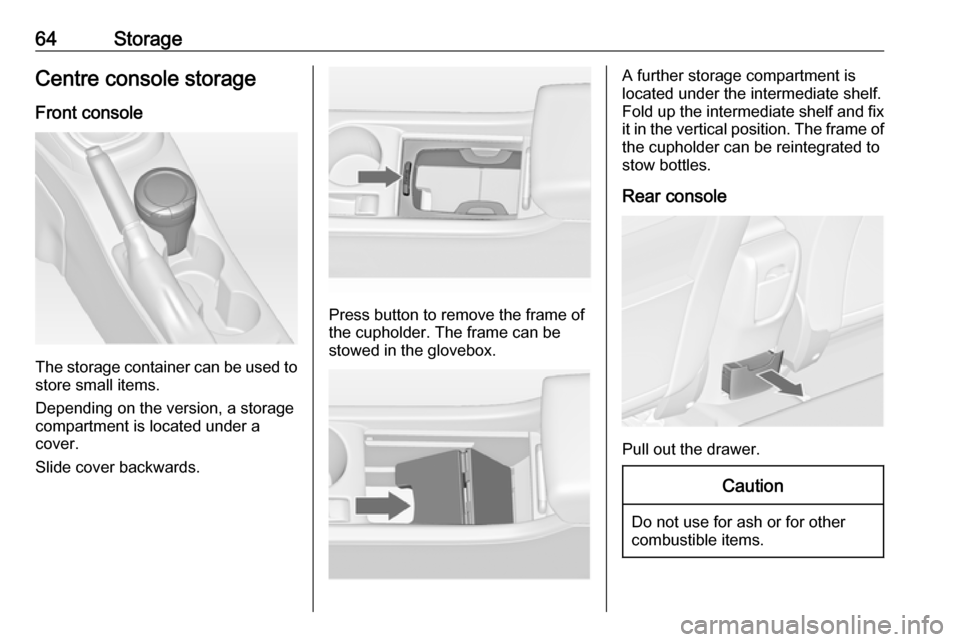
64StorageCentre console storage
Front console
The storage container can be used to
store small items.
Depending on the version, a storage
compartment is located under a
cover.
Slide cover backwards.
Press button to remove the frame of
the cupholder. The frame can be
stowed in the glovebox.
A further storage compartment is
located under the intermediate shelf.
Fold up the intermediate shelf and fix it in the vertical position. The frame of
the cupholder can be reintegrated to
stow bottles.
Rear console
Pull out the drawer.
Caution
Do not use for ash or for other
combustible items.
Page 67 of 343
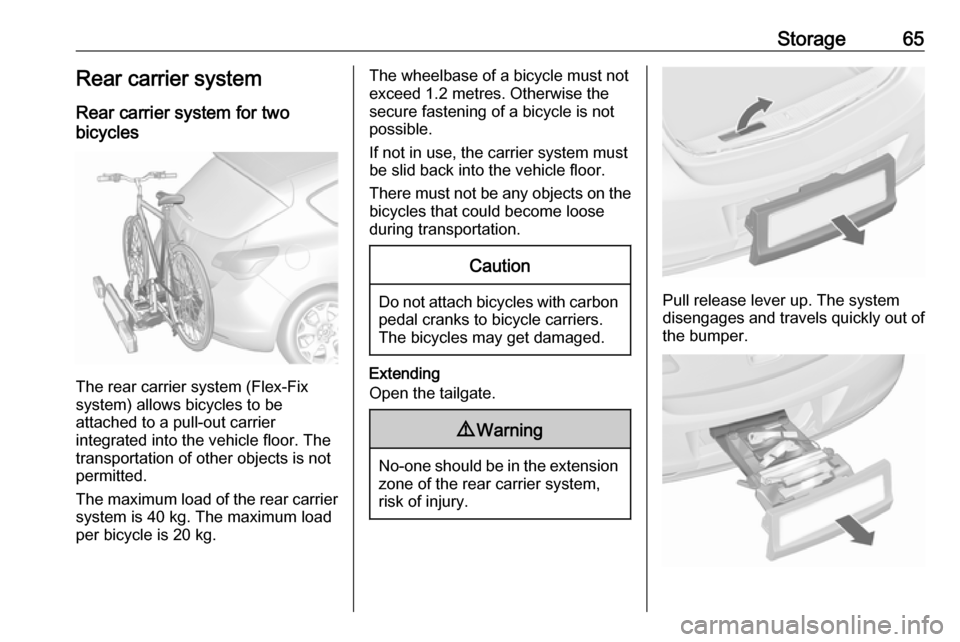
Storage65Rear carrier system
Rear carrier system for two
bicycles
The rear carrier system (Flex-Fix
system) allows bicycles to be
attached to a pull-out carrier
integrated into the vehicle floor. The
transportation of other objects is not
permitted.
The maximum load of the rear carrier
system is 40 kg. The maximum load
per bicycle is 20 kg.
The wheelbase of a bicycle must not
exceed 1.2 metres. Otherwise the
secure fastening of a bicycle is not possible.
If not in use, the carrier system must
be slid back into the vehicle floor.
There must not be any objects on the bicycles that could become loose
during transportation.Caution
Do not attach bicycles with carbon pedal cranks to bicycle carriers.
The bicycles may get damaged.
Extending
Open the tailgate.
9 Warning
No-one should be in the extension
zone of the rear carrier system,
risk of injury.
Pull release lever up. The system
disengages and travels quickly out of
the bumper.
Page 68 of 343
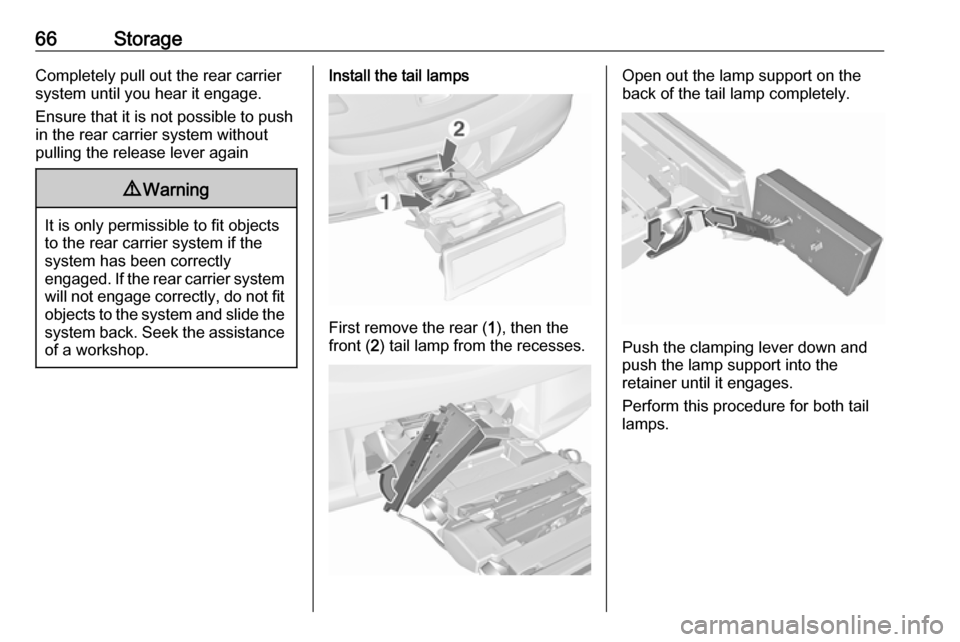
66StorageCompletely pull out the rear carriersystem until you hear it engage.
Ensure that it is not possible to push
in the rear carrier system without
pulling the release lever again9 Warning
It is only permissible to fit objects
to the rear carrier system if the
system has been correctly
engaged. If the rear carrier system
will not engage correctly, do not fit
objects to the system and slide the system back. Seek the assistance
of a workshop.
Install the tail lamps
First remove the rear ( 1), then the
front ( 2) tail lamp from the recesses.
Open out the lamp support on the
back of the tail lamp completely.
Push the clamping lever down and
push the lamp support into the
retainer until it engages.
Perform this procedure for both tail
lamps.
Page 69 of 343

Storage67
Check the cable and lamp position to
ensure these are correctly installed
and are securely located.
Lock the rear carrier system
Swivel the right clamping lever ( 1)
first, followed by the left clamping
lever ( 2), until a resistance is
noticeable.
The rear carrier system is locked
when the clamping levers are
swivelled by approx. 50°. Otherwise
safe functionality is not guaranteed.
Notice
Close the tailgate.
Unfold pedal crank recesses
Fold one or both pedal crank
recesses upwards until the diagonal
support engages.
Page 70 of 343

68StorageRemove the pedal crank mounts from
the pedal crank recesses.
Adapting the rear carrier system to a
bicycle
Press the release lever and withdraw
the wheel recesses.
Push the release lever on the strap
retainer and remove the strap
retainer.
Prepare the bicycle for attachment
Notice
The maximum width for the pedal
crank is 38.3 mm and the maximum
depth is 14.4 mm.
Rotate the left pedal (without a chain
cog) vertically downwards. The pedal
on the left pedal crank must be
horizontal.
The front bicycle must have its front
wheel facing left.
The rear bicycle must have its front
wheel facing right.
Attaching a bicycle to the rear carrier
system